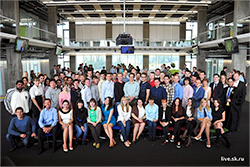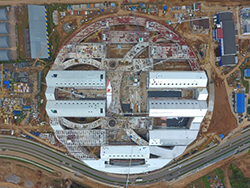
| Vol.
XXIX No.
2 November / December 2016 |
| contents |
| Printable Version |
Skoltech – A Personal and Professional Journey
Journey Begun
I was at an airshow with my son on the Fourth of July, 2011 when I received a call from Duane Bonning – was I interested in flying to Moscow to interview for the position of Skoltech President? When you come to a fork in the road, take it! This would either be the job of a career, or a really bad idea. As it turns out, it was the opportunity of 10 careers – to found not only a new university, but a new type of university centered on innovation, and designed to be an engine of economic growth.
This opportunity was a little less daunting for me than you might think – I had studied six years of Russian in high school and at MIT (thanks to a strong humanities program), enrolled one semester at Leningrad State University in the middle of the Cold War, and worked with the Soviet space universities in the late 80s. This was my third stint in Russia.
Facts on the Ground
Five years later, when I stepped down this past spring, we had succeeded in starting a new university. It has 10 international research programs, five Masters and PhD degree programs, a unique innovation program, over 75 faculty recruited from around the world, and 450 graduate students (about 20% international by design). The university is in interim buildings, and in the fall of 2017 will move into more than 1.4 million square feet of beautiful and state-of-the-art campus buildings. Zero to one-quarter of CalTech in five years. This could not have happened without the instrumental support of MIT, the Russian government, the academic community in Russia, the Russian Academy of Science, and other universities around the world.
Background
In order to understand Skoltech (Skolkovo Institute of Science and Technology), it is important to view the context of modern Russia. On one hand, the economy runs on export revenues of raw materials, while almost everything Russians buy is imported. On the other hand, there are 300 years of scholarly tradition at the Russian Academy of Science, and a still vibrant university system.
(My professional assistant was the daughter of the last student of Kolmagorov – you don't find that just anywhere!) Russia has an engineering community that launched the first man in space.
Faced with these facts, any reasonable government would try to connect the scientific and technical horsepower with the needs of the economy. (And the parts of the government I dealt with were completely reasonable – the chair of the Skoltech Board is a Duke-trained economist and Deputy Prime Minister.) In order to make this connection, the government created the Skolkovo Foundation who are building the Skolkovo Innovation Center. It is a supersized techno-park and innovation community on the western outskirts of Moscow.
The Russian government reasoned that at the heart of any such zone of intense science-based innovation there should be a university like MIT. They decided that none of their existing institutions could pivot quickly to this role, and therefore asked a handful of universities around the world if they would partner to establish a new university. MIT agreed, and committed to a three-year partnership, later stretched to 4.5 years, and now extended to 7.5 years through a Phase 2.
Objectives and Mission
Our intention at Skoltech was to build a “University 3.0.” University 1.0 started in Bologna, to preserve and pass along knowledge. University 2.0 is Humbolt, where the new mission was to develop knowledge. In University 3.0 the application of knowledge through innovation is the central mission. At Skoltech, we were not only building a new university but a new kind of university.
Our goals are to eventually approach the world’s best universities in academic performance, and stand among the most economically impactful universities in the world. In the twenty-first century, we believe that universities will be measured on a two-dimensional scheme, in which traditional scholarly measures of impact are on one dimension, and economic impact is on the second. Leading universities have optimized the scholarly impact. However, economic impact is far from optimized, and a new entrant could, with hard work and focus, achieve a very strong position in this dimension.
Therefore, the mission is:
- To have fundamental educational, scholarly, and economic impact in the Russian Federation and around the world,
- By accelerating innovation: building integrated research/innovation programs to effectively meet the needs of industry and society, and educating graduate students to be leaders in translating knowledge from science to innovation,
- Using a fusion of exceptional Russian and international talent, key partnerships, and a world-class infrastructure, all embedded in the Skolkovo innovation ecosystem.
| Back to top |
Research Programs
The key structure at Skoltech is the Center for Research, Education and Innovation (CREI). Within one organization, the three strands of the education, innovation, and research can be integrated. CREIs are focused on societal and industrial needs. There are no departments or schools at Skoltech. CREIs are deliberately overlapping, with fluid movement of faculty encouraged.
MIT advised closely on the creation of our CREIs:
- Design, Manufacturing and Materials
- Photonics and Quantum Materials
- Energy Systems (collaboratively with MIT)
- Electrochemical Energy Storage (collaboratively with MIT)
- Hydrocarbon Recovery
- Data-Intensive Biomedicine and Biotechnology
- Functional Genomics (collaboratively with MIT)
- Computation and Data Intensive Science and Engineering
- Space
- Advanced Mathematics
Educational Programs
Skoltech runs on four two-month terms, plus the January Independent Studies Period (the original name of IAP). The graduate education is at two levels, aligned with the two upper cycles of the Bologna model – Masters and PhD. Skoltech currently offers five Masters Programs (Energy Science and Technology, Information Technology Science and Technology, Biomedical Technology and Science, Space Science and Technology, and Product Design, Advanced Manufacturing and Materials). Skoltech uses the European Credit Transfer System (ECTS), and English is the language of instruction, supporting educational mobility, especially with the EU.
Innovation Programs
Innovation is the defining activity of Skoltech. The main organization for innovation is the Center for Entrepreneurship and Innovation (CEI) that contains all of the functions that at MIT are distributed throughout Deshpande, ILP, TLO, VMS, and the Innovation Initiative.
The CEI runs programs on: building effective Networks to the Skolkovo innovation ecosystem; funding Translational Research to accelerate ideas to impact; managing Knowledge Exchange at the interface: and operation Education programs to teach students the knowledge and skills of E&I.
A unique feature of the Skoltech education in E&I is that in the first month after the students arrive they participate in an all-consuming Innovation workshop. The main learning activities are experiential – in their first month students identify needs, select a technology, and sketch out a plan for commercialization. The principal outcome is attitudinal: it changes them very rapidly from a passive student to a proto-entrepreneur.

(click on image to enlarge)
Faculty and Students
Arguably the greatest contribution of MIT was in recruiting the first cadre of faculty and students. For the first three years, all faculty candidates were screened by MIT led committees and interviewed at MIT. Many Skoltech students took terms at MIT, and the application pool was enriched by opportunity to study at MIT.
As of June 2016, we had attracted about 75 professors to the Skoltech faculty – of a long-term goal of 200. About 20% worked in Russia when hired, and 80% from abroad. However, this 80% included many members of the Russian academic diaspora. The graduate student population has a goal of 1200, and had reached the mid 400s. It contains about 20% true international students, broadly recruited from around the world.
Facilities – Interim and Long Term
Skoltech has worked in two sets of interim buildings (rental space in the Skolkovo business school, and then in the Technopark office complex). In the fall of 2017, Skoltech will move into its permanent campus (the equivalent MIT moving in 1916 – no ceremony with an ark is planned but drones may have a role).
The campus under construction will become a benchmark for university buildings. A circular ring surrounds interconnecting laboratory buildings, producing a 1,400,000 square foot academic campus – about the size of CalTech. The plan was developed by Pritzger Prize winning architects Herzog and DeMuron, and the labs designed by Payette of Boston (see figure).
Political Support
Despite the political and economic tensions within Russia and internationally, Skoltech continues to maintain strong political and financial support from the government. Diplomats in Moscow took the position that there are certain areas in which countries should continue to cooperate even when political tensions rise: culture, sport, science, and education are high on this list. In fact, two of our strongest supporters in Moscow were the U.S. and EU ambassadors.
What MIT Contributed
The contribution of MIT to Skoltech is enormous. First there is the brand: when I walked into any office in the world I was immediately viewed as the President of an MIT partner institution. The involvement in hiring was crucial, and in developing the culture of the first cadre of students. Function by function, MIT established the framework for the new university – education, research, innovation, organization, and policy. The impact of MIT on the design of the campus was very significant as well.
What MIT Should Learn
Along with the Singapore-MIT Alliance for Research and Technology, Skoltech is the major international institution-building program of MIT of the last two decades. It is complemented by a range of smaller programs, including the Cambridge-MIT Institute, Masdar, Portugal, and others. I led two of these efforts. I think that MIT should learn from these efforts:
- MIT should fundamentally reconsider if its current model of institution building as a partner, but without long-term ownership or franchise, is optimal in the long haul;
- If MIT is to continue in the current model, it should develop a system that learns organizationally from one project to another, develops faculty with prescriptive knowledge of the MIT model, who are facilitated by a strong professional staff;
- MIT should recognize its finite capacity of senior experienced faculty, the impact of the short-term loss of these folks from campus, and the downside influence on brand if the venture is not successful.
What Life Was Like For Me
Professionally, this was a unique experience. Day-by-day, it was damn tough. Month-by-month there was continuous positive progress. Personally, I had a wonderful time. Moscow is a great city. I enjoyed the classical culture, made good friends, joined the new Jack Nicklaus-designed golf club, and dined at many excellent restaurants (the best part of being a university president is that you never have to eat at home).
Closing
I would like to thank the hundreds of MIT folks who helped build Skoltech. It was not always easy, but important things seldom are. Our influence will be long lasting and significant.
| Back to top | |
| Send your comments |
| home this issue archives editorial board contact us faculty website |
